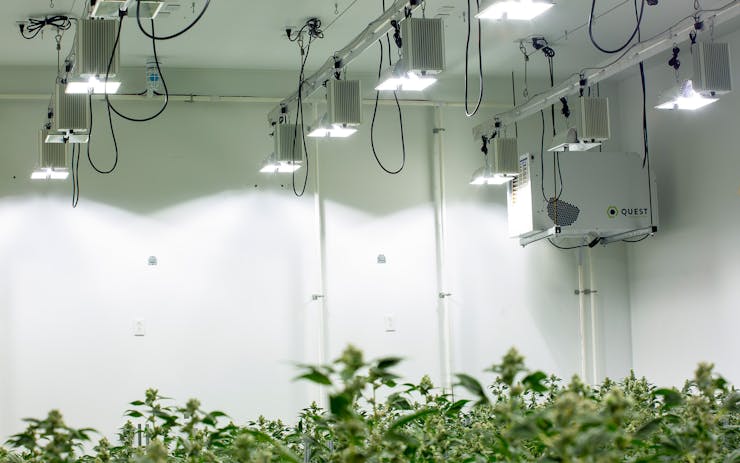Brought to you by Hawthorne Gardening Company.
Cannabis crops have existed for as long as there’s been cannabis—but thanks to prohibition and restrictions on the plant, they haven’t gotten as much agricultural attention as broccoli or roses.
Now that scientists have the opportunity to learn about cannabis plants and their vulnerabilities, we’re learning more about what separates a thriving crop from a failed experiment.
Dr. Philip Dwyer, Ph. D is a researcher for Hawthorne Gardening Company, specializing in keeping fast-growing annuals like cannabis healthy, pest-free, and thriving. We spoke with him about how to stave off destructive pathogens so you can have a successful harvest, whether your plants are indoors, in a greenhouse, or out in the open.
Identifying crop issues
Dwyer points to three problems that are especially prevalent in cannabis and similar crops: powdery mildew, Botrytis, and pythium root rot. Fortunately, they’re pretty easy to spot if you know what to look for. Depending on the condition and how bad it is, though, it could mean a diminished harvest, or even a ruined crop.
Powdery mildew
It’s pretty easy to remember and identify what this common fungal infection looks like—it’s right there in the name. If you’re seeing a powdery residue on the leaves, chances are it’s the culprit. Dwyer says it’s the biggest problem Hawthorne customers face.
“It’s most prevalent when the humidity in grow rooms is too high,” he explains. “Once it begins, it can spread from plant to plant and really cause a lot of destruction and even the loss of the crop.”
Botrytis
Also a fungus, this leaf disease pops up toward the end of the grow, mainly affecting the flowers, says Dwyer—and while it’s mostly prevalent on outdoor crops, it’s not unheard of indoors.
“You’re going to see Botrytis on tightly-packed flowers at the end of the growth cycle,” says Dwyer. “Browning out is the classic symptom there. If that happens, you’re losing your harvest and at that point, it’s crushing because you’ve done everything to grow these plants and keep them healthy.”
Pythium root rot
While Botrytis primarily affects advanced crops, conversely, pythium root rot will hit your seedlings. This one also looks about how it sounds: brown, greasy roots and shriveling leaves.
“Little plants that don’t have enough of a root system to really thrive and withstand a little bit of infection can be hit with pythium,” says Dwyer.
The best way to address plant diseases is to prevent them before they start. That’s why it’s important to carefully monitor your humidity, airflow, and other factors affecting the growing environment. Pythium thrives in wet soil. Powdery mildew grows in high humidity and disperses in low humidity. Botrytis absolutely adores damp environments, spreading on wet leaves in humid environments.
“As a pathologist, I’m looking at temperatures and periods of higher humidity,” says Dwyer. “We believe the disease is most active when levels of humidity are 55 percent or higher and temperatures are in the upper 60s to low 70s.”
Simple solutions to stop crop trouble
There are some simple ways a grower can address the humidity levels in their grow, like adjusting watering times to prevent lingering humidity. Adding additional airflow machinery to a grow room can result in a more stable environment, too. He recommends fans that can keep air moving and dry off surfaces but notes that larger grow operations could benefit from a dehumidifier.
Stacking dehumidification controls with other measures that you take at the very beginning of a grow can help ensure a successful crop, along with using Hawthorne’s favorite method – a common practice called integrated pest management or IPM.
“It’s much like human health: if you are not getting enough sleep, eating poorly, doing other things, it’s much easier to become sick and it’s harder to recover,” he says. “Whereas if you’re doing the right things, making the right choices, the likelihood of good health is there.”
It starts with a clean growing space, then building on those good environmental conditions with the right lighting. Then you start watching for potential issues so your plants can recover quickly.
Exiling pests and fungi
Sometimes, a crop is too far gone. Widespread Botrytis or powdery mildew can wipe out whole swaths of plants. But if you catch it early, you have options, including organic ones.
Botrytis and powdery mildew are both caused by a fungus, and Dwyer recommends a combination fungicide, miticide, and insecticide from General Hydroponics, a brand under the Hawthorne umbrella.
“Exile (a product that delivers fungicide, miticide, and insecticide to plants) works to help suppress diseases that are affecting your plants as they’re growing,” says Dwyer. It’s an EPA-certified product that Hawthorne’s research has shown works well on hemp. And it’s promising enough that Hawthorne is in the works to develop more new products for cannabis and other fast-growing annual crops of the future.
“If people wanted to grow strawberries, there’d be 100 years of data on what I’d suggest,” he says. “But we couldn’t legally test on cannabis until recently, and now we can use it to understand how to bring solutions to growers.”
There when you need them most
There’s always going to be something to troubleshoot, and if you need assistance, expert help is a phone call away. Hawthorne offers multiple products under one roof, including ones that help with hydroponics, plant nutrition, lighting, HVAC, and benching. The multi-faceted group is well-positioned to make sure growers have setups that can see them through for long-term success—and the right products and insight to address anything that might go awry.
“I do lots of testing and research, and technical services like consults and visits with growers for lighting, nutrition controls, products, air systems,” says Dwyer. “Our goal is to help people grow great plants, and we want to have the absolute best options there for you.”
Learn more about Hawthorne Growing Company’s growing environments here.






